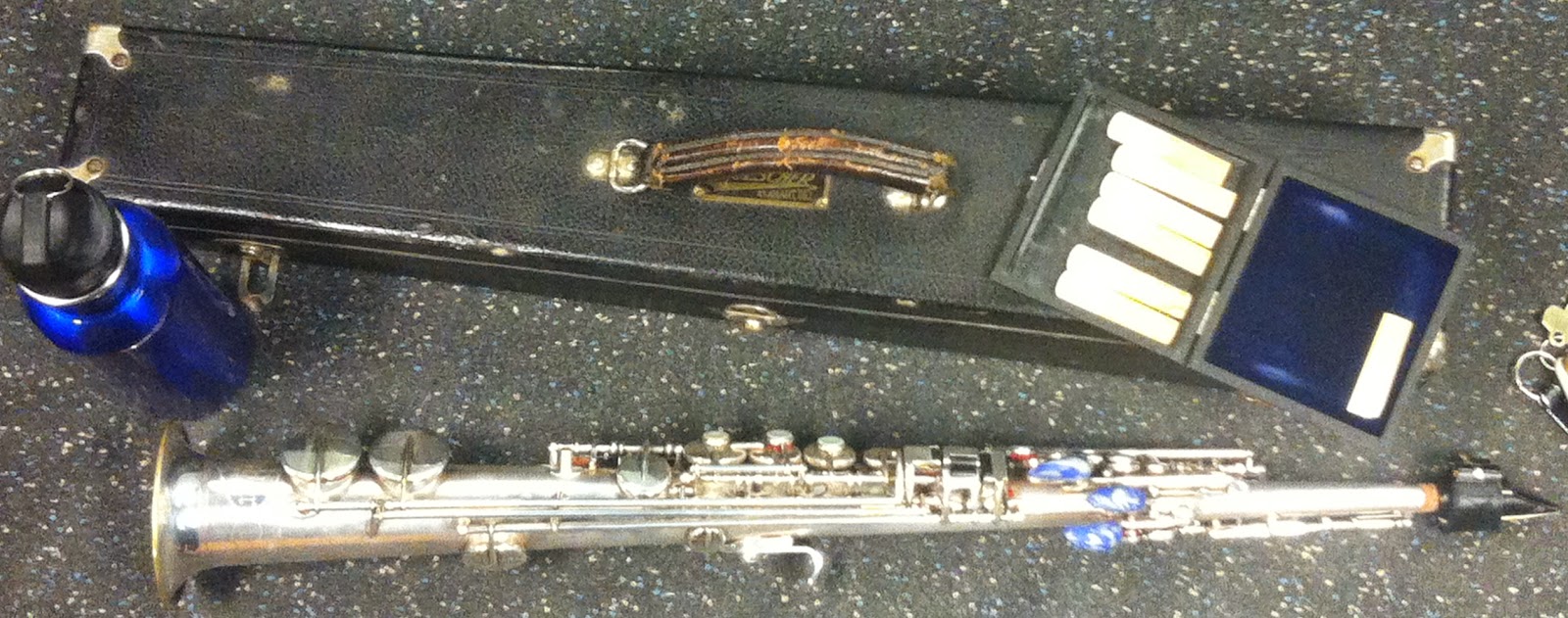I've kept a practice journal periodically ever since I was at university. They come and go and vary in detail. Last week I started a new one possibly sparked by the arrival on a new soprano (a Buescher True Tone) a week or so before.
It's been fun getting used to the new horn. Overall the ergonomics are not nearly as bad as some would lead you to believe. The transition between low B & C# is taking a bit of getting used as are the different fingerings up top (not front f key). I haven't really looked into the quarter tone fingerings but I know I will need to make some changes as the mechanism is different. I've found that getting the horn well warmed up helps the intonation tendencies to settle down a bit. Here's a rundown of the week.
Monday
Sound:
Terrace Dynamics (a la Sigurd Rascher's
Top Tones for Saxophone) on Low E.
Rascher's "Uniformity of Tone Character" - worked between low A and middle F.
Descending octaves without the octave key (aka Letting It Fall) from Low F-Bb
Overtones. Up to third overtone. Including tone matching the regular fingering with 1st, 2nd and 3rd overtones.
Ear Training:
Modus Vetus - taking a line, singing and playing it in all keys (and registers) (round the cycle of 4ths)
Modus Novus - ditto (in whole tones)
I've had these books a little while now but have only just started working with them. Expanding on the work I have done singing/playing interviews and chords.
Tune:
"September In The Rain." This tune popped into my mind one day (perhaps it was raining) so I felt it was a good sign to start working on it.
Looped melody, sang melody, played melody in a few keys. F, C#, G.
Rhythm:
All of these were played on bongos.
Warmed up on a 6/8 rhythms - counting 4/4 and 3/4 against the 6/8 accent.
Revised 3 over 2 and 3 over 4 (and vice versa).
Bell pattern over 4 pulse.
===
Tuesday
Letting It Fall
Overtones and tone matching
G with
iTablaPro drone. Terraced dynamics, swells. then G and D (all registers) against drone.
Mouthpiece only - chromatic scale up and down. major scale up and down. Range is about a 10th
Sing with Nate King Cole "Star Dust"
Roy Eldridge "Star Dust" - singing with his solo (at half and full speed).
Modus Vetus - sing and play a phrase in all keys. Used iTabla Pro as a metronome.
Modus Novus - sing and play a phrase in all keys.
"September In The Rain."
Sing with Frank Sinatra
Alternate Playing Melody and sing melody.
Started learning harmony.
===
Wednesday
Rhythm - 6/8 and some 3 over 2.
Dynamics on high G
Tone Uniformity - middle F- high Bb.
Letting It Fall
Overtones. Lots of tone matching overtone to regular finger (up to 4th overtone)
Modus Vetus 1 phrase round cycle of 4ths
Modus Novus 1 phrase round diminished cycle
September in the Rain melody in keys of E, Eb
Tune - "September In The Rain"
Alternate singing and playing the melody. Root Progression of Harmony. Outlined harmony - no set patterns - some choruses were in time others were rubato. Alternated melody with free improvisation.
Sing - Roy on "Stardust" (1/2 and full speed)
===
Thursday
Started today singing with Roy Eldridge on "Stardust."
Letting It Fall. I find this a nice place to start and find myself returning to it during practice sessions when I want to clear my mind or relax my embouchure.
Bending notes - taking a note and lowering it a semi-tone, whole-tone, minor third, as far as I can go with it. Taken from Steve Lacy's book
Findings - I forget what he calls the exercise.
Mouthpiece only.
Rhythm - 6/8 counting 4 and 3.
Modus Vetus - 1 phrase in whole tones.
Modus Novus -1 phrase in min 3rds.
"September" - sing/play melody, outline the harmony. Improvise on the tune to finish things off.
===
Friday
Rhythm - alternating hands between 4 pulse and bell pattern. Worked on this throughout the day in short spells (taking a break from school work, practice break etc).
Warmed up with a couple of minutes freely improvising.
Modus Vetus and
Modus Novus - one phrase each in all keys around the cycle of 4ths.
"September" - alternating sing one chorus, play one chorus. This always brings back memories of my lessons with Richard Tabnik.
Singing with Roy's solo on "Stardust." My version seems to be a semi-tone-ish high. I found some versions on youtube that seemed to be at the correct pitch. I may switch over to those versions.
===
Saturday
Warmed up looping the melody of "September." I then returned to work on tune in various ways (melody/singing/Harmony/Improvising) in between my other work.
One phrase from
Modus Vetus in all keys moving up in whole tones.
"September"
One phrase from
Modus Novus in all keys moving down in whole tones
"September"
Overtones - Once I worked with the first 3 over tones of various fundamentals I focused a little on the top end (4th/5th/6th overtones) off Bb fundamental.
Mouthpiece only.
"September"
Rhythm - bell pattern , alternating hands, various tempos
===
 Paul Plimley and Lisle Ellis
Paul Plimley and Lisle Ellis Paul Bley - Notes On Ornette (Steeplechase) 1997
Paul Bley - Notes On Ornette (Steeplechase) 1997






